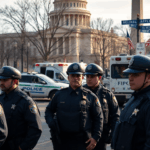Table of Contents
On a tragic Friday, a tour bus carrying 51 passengers experienced a devastating accident while returning to New York from Niagara Falls. The bus lost control on Interstate 90 near Pembroke, leading to multiple fatalities and injuries. This horrific event not only highlights the dangers of highway travel but also raises important questions about the safety protocols in place for passenger transport.
How can we better protect those who rely on these services?
The Accident: A Closer Look
The bus was traveling eastbound when it veered into the median and rolled into a ditch on the right side of the road. Eyewitness accounts and initial reports reveal that several passengers were ejected from the vehicle as windows shattered upon impact.
New York State Police Trooper James O’Callaghan shared the heart-wrenching details, confirming that there were “multiple fatalities, multiple entrapments, and multiple injuries.”
Emergency responders, including ambulances and medical helicopters, rushed to the scene to assist the injured. The passengers, primarily from Indian, Chinese, and Filipino backgrounds, required translators to communicate effectively with those affected.
This tragic event serves as a stark reminder of the vulnerabilities faced by international travelers who depend on tour services. Have we done enough to safeguard their journeys?
Implications for Passenger Safety
In the wake of this tragedy, it’s crucial to critically examine safety measures in the transport sector.
We need to look closely at driver training, vehicle conditions, and highway maintenance. While the driver survived the crash and is reportedly cooperating with investigators, understanding the exact factors that led to the loss of control is vital for preventing future incidents.
It’s clear that safety protocols for passenger transport must evolve. Regular vehicle inspections, rigorous driver training programs, and improved emergency communication systems should be at the forefront. Additionally, prioritizing roadway safety—including proper signage and maintenance—can significantly reduce accidents on our interstates.
Are we ready to make these changes?
Looking Forward: Preventive Measures
As investigations continue and the community comes to terms with the aftermath, we must consider actionable steps to enhance passenger safety on highways. Stakeholders, including transport agencies and policymakers, should work together to establish comprehensive safety guidelines specifically for tour buses and similar vehicles.
Implementing technology solutions, such as GPS tracking for real-time monitoring of bus conditions and driver behavior, could deter reckless driving. Moreover, launching public awareness campaigns to educate travelers about safety practices on the road can empower passengers to take proactive steps. How can we all play a part in making travel safer for everyone?
Ultimately, while the road ahead may be challenging, our commitment to improving safety standards can turn this tragedy into a catalyst for meaningful change. Together, we can make a difference and ensure safer journeys for all.





